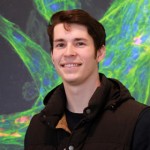 Graduate Student
Graduate Student
BS, Chemical Engineering
Columbia University
tfl2108@mit.edu
Research
My research focuses on developing new protein biosensors for reactive oxygen species that are present within biological systems. These sensors have the potential to provide quantitative information about the levels of key species in mammalian cells (e.g. hydrogen peroxide and superoxide) with high spatial and temporal resolution, and to elucidate the role that these species play in various signaling pathways and disease states in mammalian cells.
Publications
James F. Powers, Brent Cochran, James D. Baleja, Hadley D. Sikes, Xue Zhang, Inna Lomakin, Troy F.Langford, Kassi T. Stein, Arthur S. Tischler. “A unique model for SDH- deficient GIST: an endocrine related cancer,” Endocrine-Related Cancer, 2018. DOI: 10.1530/ERC-18-0115.
Troy F. Langford, Beijing K. Huang, Joseph B. Lim, Sun Jin Moon, Hadley D. Sikes. “Monitoring the action of redox-directed cancer therapeutics using a human peroxiredoxin-2-based probe,” Nature Communications, 2018. DOI: 10.1038/s41467-018-05557-y.
Troy F. Langford, William M. Deen, Hadley D. Sikes. “A mathematical analysis of Prx2-STAT3 disulfide exchange rate constants for a bimolecular reaction mechanism,” Free Radical Biology and Medicine, 2018, 120: 239-245. DOI: 10.1016/j.freeradbiomed.2018.03.039.
Beijing K. Huang, Troy F. Langford, and Hadley D. Sikes. “Using sensors and generators of H2O2 to elucidate the toxicity mechanism of piperlongumine and phenethyl isothiocyanate,” Antioxidants and Redox Signaling, 2016, in press. DOI:10.1089/ars.2015.6482.
Joseph B. Lim, Troy F. Langford, Beijing K. Huang, William M. Deen and Hadley D. Sikes. “A reaction diffusion model of cytosolic hydrogen peroxide,” Free Radical Biology and Medicine, 2016, 89: 85-90. DOI:10.1016/j.freeadbiomed. 2015.11.005.
